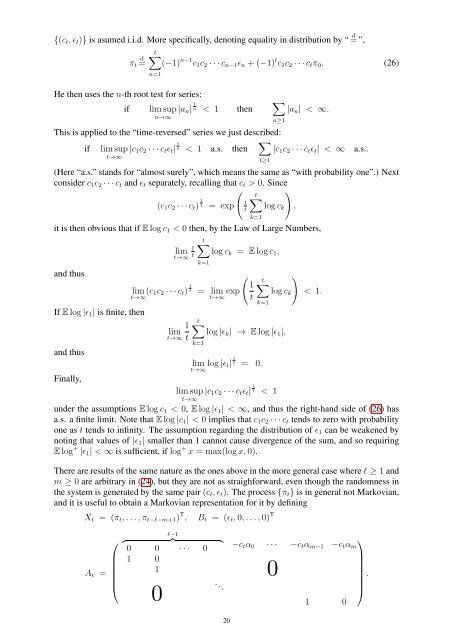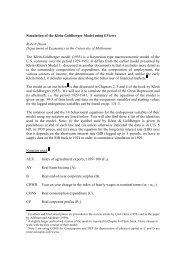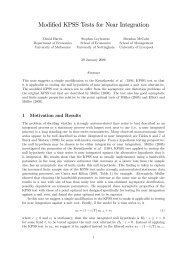Cobweb Theorems with production lags and price forecasting
Cobweb Theorems with production lags and price forecasting
Cobweb Theorems with production lags and price forecasting
You also want an ePaper? Increase the reach of your titles
YUMPU automatically turns print PDFs into web optimized ePapers that Google loves.
{(ct, ɛt)} is asumed i.i.d. More specifically, denoting equality in distribution by “ d = ”,<br />
t� d<br />
= (−1) n−1 c1c2 · · · cn−1ɛn + (−1) t c1c2 · · · ctπ0. (26)<br />
πt<br />
n=1<br />
He then uses the n-th root test for series:<br />
if lim sup |an|<br />
n→∞<br />
1<br />
n < 1 then �<br />
|an| < ∞.<br />
This is applied to the “time-reversed” series we just described:<br />
if lim sup |c1c2 · · · ctɛt|<br />
t→∞<br />
1<br />
t < 1 a.s. then �<br />
|c1c2 · · · ctɛt| < ∞ a.s..<br />
(Here “a.s.” st<strong>and</strong>s for “almost surely”, which means the same as “<strong>with</strong> probability one”.) Next<br />
consider c1c2 · · · ct <strong>and</strong> ɛt separately, recalling that ct > 0. Since<br />
(c1c2 · · · ct) 1<br />
�<br />
t�<br />
�<br />
t = exp<br />
,<br />
1<br />
t<br />
k=1<br />
t≥1<br />
n≥1<br />
log ck<br />
it is then obvious that if E log c1 < 0 then, by the Law of Large Numbers,<br />
t�<br />
log ck = E log c1,<br />
<strong>and</strong> thus<br />
If E log |ɛ1| is finite, then<br />
<strong>and</strong> thus<br />
Finally,<br />
1 lim<br />
t→∞ t<br />
k=1<br />
lim<br />
t→∞ (c1c2 · · · ct) 1<br />
t = lim exp<br />
t→∞<br />
1<br />
lim<br />
t→∞ t<br />
�<br />
1<br />
t<br />
t�<br />
k=1<br />
log ck<br />
t�<br />
log |ɛk| → E log |ɛ1|,<br />
k=1<br />
1<br />
lim log |ɛt| t = 0.<br />
t→∞<br />
�<br />
< 1.<br />
lim sup |c1c2 · · · ctɛt|<br />
t→∞<br />
1<br />
t < 1<br />
under the assumptions E log c1 < 0, E log |ɛ1| < ∞, <strong>and</strong> thus the right-h<strong>and</strong> side of (26) has<br />
a.s. a finite limit. Note that E log |c1| < 0 implies that c1c2 · · · ct tends to zero <strong>with</strong> probability<br />
one as t tends to infinity. The assumption regarding the distribution of ɛ1 can be weakened by<br />
noting that values of |ɛ1| smaller than 1 cannot cause divergence of the sum, <strong>and</strong> so requiring<br />
E log + |ɛ1| < ∞ is sufficient, if log + x = max(log x, 0).<br />
There are results of the same nature as the ones above in the more general case where ℓ ≥ 1 <strong>and</strong><br />
m ≥ 0 are arbitrary in (24), but they are not as straighforward, even though the r<strong>and</strong>omness in<br />
the system is generated by the same pair (ct, ɛt). The process {πt} is in general not Markovian,<br />
<strong>and</strong> it is useful to obtain a Markovian representation for it by defining<br />
Xt = (πt, . . . , πt−ℓ−m+1) T , Bt = (ɛt, 0, . . . , 0) T<br />
At =<br />
ℓ−1<br />
⎛ � �� �<br />
0 0 · · · 0<br />
⎜<br />
1 0<br />
⎜<br />
1<br />
⎜<br />
⎝<br />
. ..<br />
0<br />
20<br />
⎞<br />
−ctα0 · · · −ctαm−1 −ctαm<br />
⎟ 0<br />
⎟ .<br />
⎟<br />
⎠<br />
1 0







